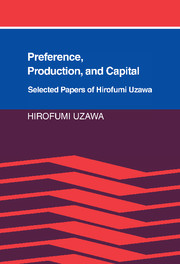Book contents
- Frontmatter
- Contents
- Foreword
- Preface
- I Preference and demand
- 1 Preference and rational choice in the theory of consumption
- 2 On the integrability of demand functions
- 3 Time preference, the consumption function, and optimum asset holdings
- II Duality and production
- III Concave programming
- IV Equilibrium and stability
- V Theory of economic growth
- VI Optimum growth
- Index
1 - Preference and rational choice in the theory of consumption
Published online by Cambridge University Press: 04 May 2010
- Frontmatter
- Contents
- Foreword
- Preface
- I Preference and demand
- 1 Preference and rational choice in the theory of consumption
- 2 On the integrability of demand functions
- 3 Time preference, the consumption function, and optimum asset holdings
- II Duality and production
- III Concave programming
- IV Equilibrium and stability
- V Theory of economic growth
- VI Optimum growth
- Index
Summary
The purpose of this paper is to study the logical foundations of the theory of consumer behavior. Preference relations, in terms of which the rationality of consumer behavior is postulated, are precisely defined as irreflexive, transitive, monotone, convex, and continuous relations over the set of all conceivable commodity bundles. A demand function associates with prices and incomes those commodity bundles that the consumer chooses subject to budgetary restraints. It will be shown that if a demand function with certain qualitative regularity conditions satisfies Samuelson's Weak Axiom of Consumer Behavior, there exists a preference relation from which the demand function is derived. On the other hand, the demand functions derived from preference relations satisfy Samuelson's Weak Axiom and those regularity conditions other than the Lipschitz condition with respect to income.
Introduction
The pure theory of consumer behavior is concerned with the structure of choices of commodity bundles made by a rational consumer when he is confronted with various prices and incomes. A large part of the theory is devoted to explaining the contents in which the rationality of a consumer's behavior is understood (e.g., Hicks, Chap. 1), Samuelson (Chap. 5), Wold and Juréen (Part 2), and Robertson (Part 1, especially pp. 13–20). According to the contributions of Pareto, Slutsky, Hicks and Allen, Wold, and others, it is now fairly generally agreed that the rationality of a consumer's behavior may be described by postulating that the consumer has a definite preference over all conceivable commodity bundles and that he chooses those commodity bundles that are optimum with respect to his preference subject to budgetary constraints.
- Type
- Chapter
- Information
- Preference, Production and CapitalSelected Papers of Hirofumi Uzawa, pp. 3 - 26Publisher: Cambridge University PressPrint publication year: 1989
- 2
- Cited by



